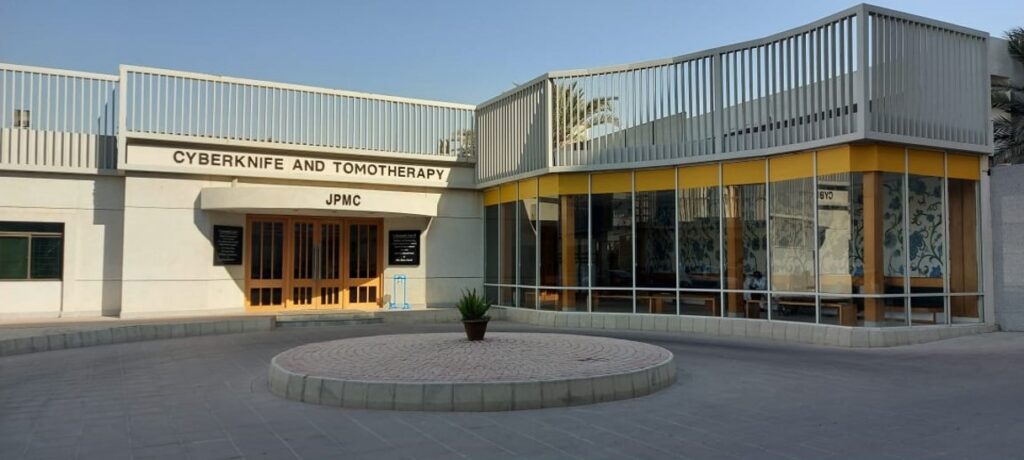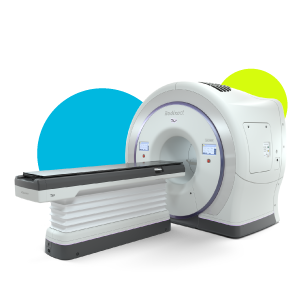As the fifth-most-populous country in the world, Pakistan provides a powerful case study in examining gaps in access to cancer care, including radiotherapy access and disparities in cancer outcomes. To better understand these gaps — and potential solutions — we sat down with Dr. Tariq Mahmood, Head of the Department of Radiation Oncology CyberKnife® Robotic Radiosurgery & Tomotherapy at Jinnah Postgraduate Medical Centre (JPMC), Karachi, Pakistan.

Dr. Mahmood is leading the charge in closing care gaps by focusing on three key factors:
- Eliminating financial barriers to treatment through unique private-public funding partnerships
- Increasing the capacity of radiotherapy treatment centers by investing in leading-edge treatment technologies
- Changing perceptions of radiation therapy — among radiation oncologists and the broader public — by raising awareness of the “miraculous” results enabled by today’s most advanced treatment modalities
Understanding cancer care gaps in Pakistan
Per the most recent (2020) data from the World Health Organization (WHO), Pakistan sees approximately 178,000 new cancer cases and 118,000 deaths from cancer annually.[1] This represents a significant burden, with an age-standardized cancer mortality rate of 70 per 100,000 people — higher than many other countries with similar healthcare challenges.
Across all types of cancer, roughly 60 percent of patients diagnosed with cancer in Pakistan need radiotherapy.[2] Yet only 21.4% have access to such care. As with many other low- to middle-income countries, this disparity is understood as a complex interplay between geographic and financial limitations to access, undergirded by a shortage of clinical staff and the relative expense of radiotherapy delivery systems.
Lack of technology
Recent data from the Global Cancer Observatory shows Pakistan has only 20 radiotherapy centers for a population of over 230 million (WHO recommendation is one per 500,000 people). More specifically, there are just 90 radiation treatment units across all of Pakistan (benchmark is one unit per one million people).[3]
Talent shortages
Compounding this undersupply of treatment technology, Pakistan also has a shortage of oncologists and trained medical physicists (1 radiation oncologist per 250-300 patients and 1 radiation technologist per 100-150 patients).[4]
Access and affordability issues
Perhaps most important of all, the vast majority of cancer patients in Pakistan cannot afford radiotherapy treatments. Roughly 75% of health care in the country is delivered through the private sector, with an estimated 78% of the population paying out-of-pocket for health services.[5] This makes it challenging, if not impossible, to justify investment in the relatively expensive radiotherapy delivery systems — or hiring additional clinical staff.
Dr. Mahmood’s personal story: Bringing the best possible cancer care to Pakistan
Dr. Mahmood is not a radiation oncologist. Rather, he began his career as a radiologist in 1994. But in 2011, his mother was diagnosed with cancer. “I experienced the pain of that cancer,” he says. “I was looking for the best possible treatment for her on the earth — and at that stage, I came to know that the CyberKnife [System] was the best, safest modality to treat her.”
Unfortunately, in 2011, there were no CyberKnife Systems in Pakistan.
Dr. Mahmood was working at JPMC, a public sector hospital with 2,200 beds, built through a public-private funding partnership and offering completely free care. JPMC provided treatment for all types of cancer, including chemotherapy and a surgical department doing all types of surgical procedures. But JPMC reflected the broader gap in access to radiotherapy, with just one Cobalt unit, used primarily for palliative treatments.
“At that time, I decided that, if not for my mother, I will make sure that this equipment is available in Pakistan and offered to all others who cannot afford to have treatment,” says Dr. Mahmood.
Why the CyberKnife System?
“In terms of radiation technology, Pakistan is around 40 years behind the rest of the world, unfortunately,” says Dr. Mahmood. When his mother was diagnosed with cancer, he dove into the clinical literature, evaluating the newest and most innovative treatments. “No other equipment can match the safety and precision of the CyberKnife [System],” he says.
More broadly, Dr. Mahmood recognized the versatility of the CyberKnife System as equally transformative: “Gamma Knife can only treat the brain, but the CyberKnife System can treat prostate, lung, pancreas, and other areas,” he says.

Overcoming financial barriers: Making cancer treatment free
While evaluating the feasibility of installing a CyberKnife System, Dr. Mahmood did a study that suggested not more than 5% of individuals could afford CyberKnife treatment on their own. “So, we decided that whatever we install at JPMC, the facility will be absolutely free of charge, irrespective of nationality, religion, and ethnicity,” he says.
JPMC successfully raised the funds in around four months, installing its first CyberKnife System in 2012. “Once we successfully installed and operated that first CyberKnife System, people developed trust in us,” says Dr. Mahmood. “We are very lucky that we have the trust of donors. They have not only contributed for the purchase of the equipment but are also regularly contributing for the maintenance contract fee and the costs of the building and staff. Our Government of Sindh also joined hands and pledged to pay for the maintenance cost of all equipment used in diagnosis and treatment of cancer including PET-CT, Cyclotron CT & MR SIMs and more”.
Dr. Mahmood believes JPMC may be the only facility in the world offering free treatment on the CyberKnife System. But it’s not just clinical care that’s free. While most patients are “day-care” cases, patients requiring hospitalization do not pay for inpatient stays. “We also have an area where we provide free meals to the dependents,” he says, “We have a very holistic approach.”
Expanding radiotherapy at JPMC
After installing that first CyberKnife System in 2012, JPMC built momentum by demonstrating what Dr. Mahmood calls the “miraculous” capabilities of leading-edge radiotherapy. This real-world proof helped to raise additional funds to expand the radiotherapy program at JPMC. The facility upgraded its original CyberKnife System and added a second CyberKnife System in 2018. “This year the Government of Sindh provided funds to procure a third CyberKnife S7TM System, a top of the line unit that has fixed cones, IrisTM Variable Aperture Collimator and InCiseTM Multileaf Collimator. This unit will be able to treat patient in around 25 minutes,” he says.

Moreover, Dr. Mahmood notes that the CyberKnife System is not right for every indication and every patient, so JPMC looked to add other radiotherapy treatment technologies. “The benchmark for us is: Whatever I feel would be best for my mother, that should be offered to others,” he says. “This led to the installation of the TomoTherapy platform including the Radixact® X9 System in 2020 and last month [October 2024] we installed our second Radixact® X9 System.”
“So far, we have delivered 20,668 radiosurgery sessions with the CyberKnife System and around 23,226 radiotherapy sessions with the Radixact System,” says Dr. Mahmood. “We’ve treated patients from 167 cities in Pakistan — and 15 different countries.”

Precision and efficiency: Delivering the best cancer treatment to more patients, every day
Dr. Mahmood has become an unabashed evangelist for Accuray technologies: “I am in love with Accuray equipment,” he says. “It’s precise. Patient recoveries are uneventful. And results are miraculous.”
But JPMC’s rationale for upgrading to the latest CyberKnife and TomoTherapy technology included more than just capturing gains in treatment precision. These leading-edge systems have allowed JPMC to substantially increase treatment efficiency and patient throughput — treating more patients every day.
“Previously, we were doing eight patients a day with the first CyberKnife and 12 patients a day with the second CyberKnife,” says Dr. Mahmood. “Replacing the first unit with the new CyberKnife S7 model, we are very optimistic that we will be able to do 20-24 cases on there — hopefully doing around 30+ cases every day on the two CyberKnife units, and 120 patients a day on the two TomoTherapy units.”
Raising awareness of better cancer outcomes through advanced radiotherapy modalities
Dr. Mahmood notes that one of the big barriers to adoption of advanced radiation therapy modalities is low awareness in the clinical community. In the early years after JPMC implemented its first CyberKnife System, broader awareness of advanced treatment modalities remained problematically low across the radiation oncology community in Pakistan.
“Some of the very senior radiation oncologists in the country — even though they were trained abroad — they were not well aware about the advantages of CyberKnife and TomoTherapy Treatment Delivery Systems,” he says.
So, Dr. Mahmood took it upon himself to help resolve that awareness gap. “We have started inviting radiation oncologists, physicists and surgeons from across Pakistan, and we have created a lot of awareness about the miraculous results,” he says. “Now, everybody knows about the CyberKnife facility. They know it as a “MAGIC KNIFE”. And when it comes to acoustic neuroma, schwannoma, and other difficult cases, CyberKnife is now the gold standard.” Dr. Mahmood notes that JPMC recently successfully treated a metastatic case with 92 metastases in the brain. “These are results which are truly miraculous — which you can’t get with any other treatment,” he says.
Growing awareness of outcomes like these has also begun to shift public perceptions of radiation therapy — and views on cancer diagnoses more broadly in Pakistan. “With the number of patients coming from across Pakistan, the impression of radiation oncology has completely changed,” says Dr. Mahmood. “Now, patients ask for and opt for radiation before going for surgery or instead of going for surgery — and that is because of the precision and safety which we achieved with the CyberKnife System.”
A public-private partnership — committed to closing care gaps
The success of the radiotherapy program at JPMC created a flywheel effect in its fundraising efforts — boosting support both with organization’s private donors and local government agencies. “We are very optimistic about the future,” says Dr. Mahmood. “We have plans to grow our funding, and the government is also be contributing in that, matching dollar to dollar with our fundraising.”
Headlining that future is a plan for a 12-story centre “Jinnah Institute of Cancer & Research.” JPMC already has a private donor lined up to contribute $30 million for the building, and the local government agency has agreed to fund the equipment for the new facility.
These efforts to expand access to leading-edge cancer care are just one part of the broader goal of closing care gaps at JPMC. “We firmly believe in the vision of closing the care gap, and we are very happy to be part of that campaign,” says Dr. Mahmood. “Over the last 12 years, we have been able to raise $106 million USD from the civil society and invest in this hospital — adding 1,100 new beds at JPMC, and now we are close to raising $34 million USD in year 2025 which will raise its beds to 2600.”
For Dr. Mahmood, these achievements all tie back to Almighty God: “I have dedicated my life to free cancer care. So even though I retired last December, I come here every day as a volunteer from 10am to 5pm,” he says. “It touches your heart to see that you can literally save lives and save patients from the misery of the disease. It’s changed my life.”
References
- https://www.who.int/publications/m/item/cancer-pak-2020
- https://pmc.ncbi.nlm.nih.gov/articles/PMC10752456/
- https://www.redjournal.org/article/S0360-3016(19)30648-0/pdf#:~:text=There%20are%20currently%2057%20radiation,new%20cancer%20cases%20per%20year.
- https://pmc.ncbi.nlm.nih.gov/articles/PMC10752456/
- https://www.redjournal.org/article/S0360-3016(19)30648-0/pdf#:~:text=There%20are%20currently%2057%20radiation,new%20cancer%20cases%20per%20year
The views contained and expressed in this blog, are those of the author and do not necessarily reflect the views or policies of Accuray Incorporated or its subsidiaries. No official endorsement by Accuray Incorporated or any of its subsidiaries of any vendor, products or services contained in this blog is intended or should be inferred









